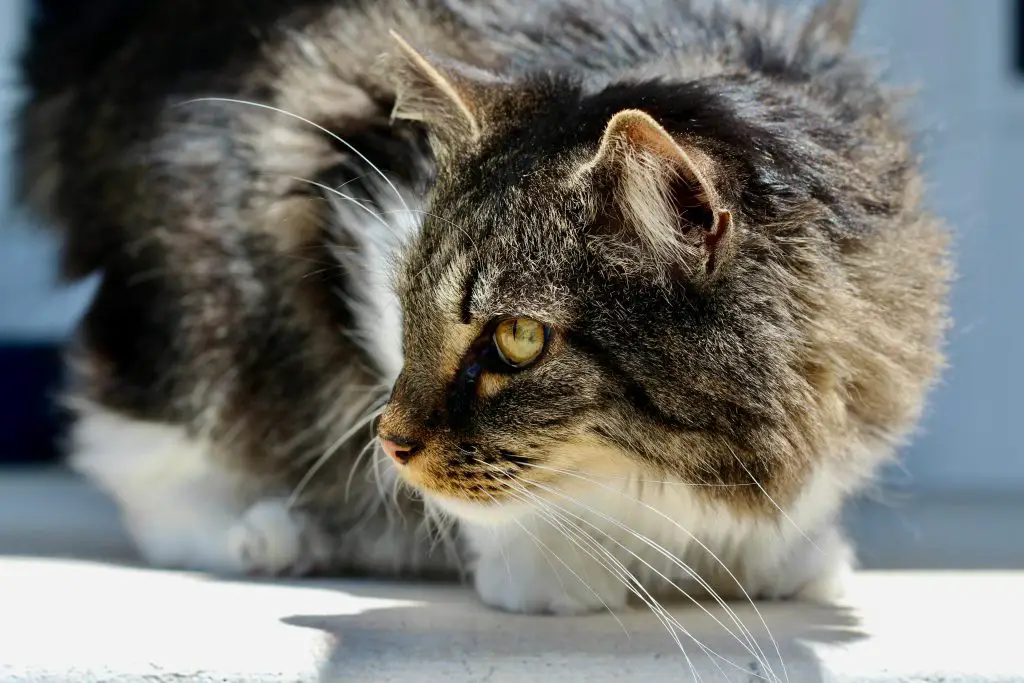
To help your cat become a sweetheart, tune into their body language cues. Praise good behavior promptly with treats or cuddles.
Use slow and steady socializing methods such as interactive play and rewards to establish trust.
Stick to a set schedule for meals, playtime, and rest to provide a sense of security. Be gentle when handling your furry friend, cradling them softly and speaking in a soothing tone.
Respect their petting preferences and watch for signs of being overwhelmed.
Stay committed to these techniques to nurture a well-mannered and loving companion.
Explore the benefits of consistent play and stress-relief to further enrich your cat’s behavior.
This post contains affiliate links. However all the information provided on this site are my own honest opinions. See more in Disclaimer.
Table of Contents
Key Takeaways

- Reward your cat’s good behavior with treats or affection right away to reinforce positive actions.
- Introduce your cat to new experiences and interactions gradually to help them socialize in a positive way.
- Stick to consistent routines for feeding, playtime, and grooming to provide a sense of stability and security.
- Handle your cat with care and confidence, supporting their body and using calming tones when interacting.
- Watch for your cat’s body language cues to prevent overstimulation and foster a trusting relationship.
Understand Cat Behavior
To effectively train your cat, it’s crucial to understand their behaviors and motivations. Cats communicate through body language, so watch for cues like ears, tail, and posture.

An arched back and fluffed-up fur indicate feeling threatened, while a slow blink shows trust and affection.
Recognizing your cat’s instincts is key. They’re natural hunters, so activities that mimic hunting can satisfy their needs and prevent unwanted behaviors.
Socialization from an early age with various environments and beings shapes their behavior positively.
Positive Reinforcement

Successfully training your cat to be nice involves using positive reinforcement to reward desired behaviors.
Consistent training sessions will help reinforce these behaviors effectively, allowing your cat to associate good behavior with positive outcomes.
Reward Desired Behaviors
Reward your cat’s good behavior with treats or affection right away to reinforce positive actions. This positive reinforcement helps your cat understand which behaviors are desired.

Clicker training can be very effective in shaping behavior in cats. Using a clicker allows you to pinpoint the exact moment your cat does the right thing, making it clear which behavior is being rewarded.
Pair the clicker sound with a treat to strengthen this association.
High-value treats that your cat loves can be used consistently to reward behaviors like using a scratching post or responding to commands.
By promptly rewarding these actions, you help your cat learn what behaviors are acceptable and encouraged.
Consistent Training Sessions
Consistent training sessions are key to reinforcing positive behaviors effectively. Clicker training can be a valuable tool in this process.

When your cat displays a desired behavior, use the clicker followed by a treat. This helps your cat associate the sound with positive actions.
Consider keeping a behavior chart to track progress. Documenting each session can help you identify patterns and areas for improvement.
It also keeps you focused and on track with your training goals.
For unwanted behaviors, timeouts can be useful. If your cat misbehaves, calmly place them in a quiet, safe space for a short time.
This teaches them that certain actions result in a temporary loss of freedom.
Distraction training is another helpful technique. When your cat engages in negative behavior, redirect their attention to a toy or activity they enjoy.
This not only stops the unwanted behavior but also channels their energy in a positive direction.
Socialization Techniques

To help your cat become more sociable, try focusing on gradual positive interactions and incorporating playtime and rewards.
Introduce new experiences slowly, making sure each encounter is enjoyable. Use interactive play sessions and treats to encourage good behavior.
Gradual Positive Interactions
Creating a safe and comfortable environment is crucial for introducing your cat to new experiences. Patience is key in building trust; rushing can lead to stress.
Use treats and gentle petting as rewards for calm behavior to reinforce positive experiences.
Effective communication is essential for bonding with your cat. Pay attention to their body language and signals to understand their feelings.
If your cat seems anxious, give them space and try again later. Consistency and calmness in your approach help build trust.
When introducing new people or animals, start with short, controlled interactions and gradually increase the duration as your cat gets more comfortable. Always supervise to ensure positive experiences.
With time, your cat will associate new experiences with positive outcomes, improving their social behavior.
Playtime and Rewards
Regular playtime with interactive toys is a great way to strengthen your bond with your cat.
Trending in Cats:

Interactive toys mimic hunting, encouraging natural behaviors and providing both physical exercise and mental stimulation.
Use treats to reinforce positive behavior during playtime, like rewarding your cat when they catch a toy or follow a cue.
Vary the types of toys to keep your cat interested, such as feather wands, laser pointers, and puzzle feeders.
Observe your cat’s body language and energy levels during play to prevent overstimulation. Short, frequent play sessions are more effective than long ones.
Consistent Routines
Creating a consistent routine is key for helping your cat feel secure and behave well. Cats thrive on predictability, so stick to regular feeding times to build a sense of reliability.

Make bedtime calming with light play or gentle petting before sleep.
Include grooming and playtime in your daily routine. Set a specific time for grooming each day to strengthen your bond.
Schedule play sessions to keep your cat mentally and physically engaged.
Gentle Handling
Handle your cat with gentle and confident movements to build trust and reduce anxiety.

Cats respond well to calm and deliberate actions, so avoid sudden movements or loud noises that may startle them.
Support your cat’s body when picking them up by placing one hand under their chest and the other under their hindquarters.
This helps them feel secure and prevents discomfort or fear. Speak softly to your cat in a soothing tone to enhance their sense of safety.
Pet your cat in areas they enjoy, like behind the ears or under the chin, and watch for signs of overstimulation, such as tail twitching or flattened ears.
If your cat shows these signals, give them space.
Regular, gentle handling sessions can strengthen your bond and make your cat more receptive to touch.
Play and Exercise
Incorporate play and exercise into your cat’s daily routine to keep them mentally stimulated and physically healthy.

Interactive toys like feather wands and laser pointers can provide the mental stimulation they crave.
For outdoor exploration, ensure a safe environment or use a secure cat enclosure for supervised play.
Climbing structures like cat trees and perches encourage physical activity, while scheduled play sessions keep your cat engaged and active.
Stress Reduction
Reducing stress in your cat’s environment is crucial for promoting a happier and well-adjusted pet. Cats are sensitive beings, and small changes can spark significant tension.
Keep a stable routine for feeding, playtime, and bedtime to create predictability and help ease anxiety.
Keep your cat mentally engaged with interactive toys, puzzle feeders, and play sessions to satisfy their hunting instincts and reduce stress-induced behaviors.
Create a cozy retreat with calming aids like Feliway diffusers, gentle petting, and soothing music for a peaceful atmosphere.
Provide vertical spaces like shelves or cat trees for your cat to climb and observe their surroundings, promoting a sense of control and lowering stress levels.
Frequently Asked Questions

Training a cat to be nice is a journey that can take some time. By using the right methods and being patient and consistent, you may see progress in a few weeks to a few months.
Remember, each cat is different, so the timeline can vary based on their individual personality.
Of course! Older cats can absolutely learn new behaviors with the right training methods. By being patient, understanding, and using positive reinforcement, you can help your senior feline adjust their behavior.
Keep at it, and you’ll see positive changes in how they behave?
If your cat is being stubborn, don’t worry! It might be helpful to consult a professional for behavior tips. Remember, patience and consistency are crucial.
With dedication, you’ll probably notice improvements in your cat’s behavior over time.
Breed differences and personality traits can impact how easily a cat can be trained to be nice. Some breeds are naturally more social, but your training methods and influence as an owner are crucial factors.
Adapting your approach to your cat’s individual personality can lead to better results.
When dealing with aggressive behavior, remember to stay calm and use positive reinforcement methods. Reward moments of calmness and redirect aggression with toys or interactive play.
Make sure to provide plenty of mental and physical stimulation to keep your cat engaged and satisfied. Avoid punishing your cat, as it can lead to increased stress and aggression. See our post how to stop cat scratching and how to stop your cat biting and attacking.
Absolutely! With the right approach, you can train your cat to do tricks just like a dog. Positive reinforcement methods such as clicker training and cat agility exercises can help stimulate their natural instincts and keep them active.
Give it a try and have fun teaching your feline friend some cool tricks! See our post how to train a cat to do tricks.
Feeling like you’ve got a mini ruler demanding cuddles at 3 am? To curb your cat’s nighttime wake-up calls, try consistent sleep routines and learn about their nocturnal instincts.
Understanding your cat’s behavior can help you both get a good night’s sleep.
Gently help your cat adjust to new pets or people by taking it slow and giving them time to get used to each other.
Address any possessive behaviors with positive reinforcement and create a peaceful environment for everyone to enjoy.
Yes. Start by leash training indoors, then slowly introduce them to harnesses and short walks.
Remember to reward their obedience with treats and praise to make the training process fun and enjoyable for both of you! See our post how to train a cat to walk on a leash here.
Wow, you’re a real-life cat whisperer for taking on the challenge of taming a wild feline! Slow and steady wins the race here – with a sprinkle of patience and a dash of consistency, you’ll have that skittish stray eating out of your hand in no time.
Absolutely! Meet Whiskers, a remarkable deaf cat who thrived with reward-based training using vibrations.
With some patience and creativity, you can tailor training techniques to suit your special cat’s needs. Let’s embrace the challenge and bring out the best in them together!
By mixing up the rewards and staying consistent with reinforcement, you’ll help your feline friend learn to listen to your cues, not just crave treats. Let’s keep it fun and exciting for both of you!
Conclusion

Training your cat to be nice is like building a friendship with a mysterious artist. By using positive reinforcement, sticking to routines, and handling them gently, you can bring out their kinder side.
Just like Pygmalion transformed Galatea, your patience and understanding will help them become a more loving companion.
Remember, play and exercise aren’t just for fun—they’re important for reducing stress and encouraging socialization.
Keep it up, and you’ll see your feline friend transform into a caring presence.









